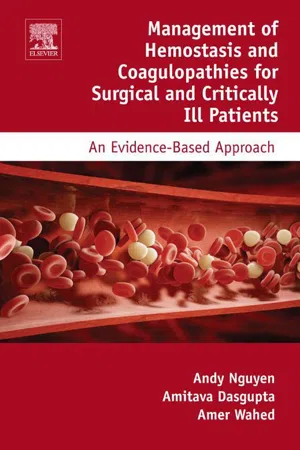
Management of Hemostasis and Coagulopathies for Surgical and Critically Ill Patients
An Evidence-Based Approach
Andy D. Nguyen,Amitava Dasgupta,Amer Wahed
- 174 Seiten
- English
- ePUB (handyfreundlich)
- Über iOS und Android verfügbar
Management of Hemostasis and Coagulopathies for Surgical and Critically Ill Patients
An Evidence-Based Approach
Andy D. Nguyen,Amitava Dasgupta,Amer Wahed
Über dieses Buch
Management of Hemostasis and Coagulopathies for Surgical and Critically Ill Patients: An Evidence-Based Approach offers a concise guide to a sub-specialty of transfusion medicine from the clinical laboratory perspective. It focuses on the clinical tests that may be done during preoperative assessment, intraoperative, and postoperative assessment and management of surgical or critically ill patients. Management of hemostasis and coagulopathies is approached from an evidence-based perspective—the coagulation status of a patient according to the laboratory test results. Algorithms and decision-support software, designed by the authors, guide clinicians with an additional tool to base transfusion dosage on specific laboratory results, including the use of an artificial neural network for predicting more accurate blood use.
Chapters reflect the experience of all three authors who have successfully applied the algorithm for better patient management as well as decreased wastage of expensive blood products, from both the clinical laboratory/pathology and clinical medicine perspective. This book will appeal to a broad section of clinical laboratory and medical practitioners from hematopathology, to internal medicine, surgery, and anesthesiology. For hematopathologists and pathologists who are involved in laboratory medicine and transfusion medicine, this book will help them understand the proper utilization of blood products and how to avoid unnecessary waste and costs for the hospital. For general surgery practitioners, this book will provide practical guidelines on how to use blood products rationally for best medical practice. Internists will also gain insight from this book, learning which patients are at higher risk of bleeding during surgery so that they can alert their clinical colleagues.
- Focuses on the clinical tests that may be done during preoperative assessment, intraoperative, and postoperative assessment and management
- Explains new decision-support software developed by the authors as a tool for the management of bleeding patients
- Reviews common coagulation based tests (indication and interpretation) that are used to assist in the management of bleeding patients
- Provides an overview of various blood products, pharmacotherapeutic agents, antiplatelets, and anticoagulants, their usage strategy, indications, and therapy goals
Häufig gestellte Fragen
Information
Coagulation-Based Tests and Their Interpretation
Abstract
Keywords
1.1 Introduction
1.2 Complete Blood Count
1.3 Tests for Platelet Function
1.3.1 PFA-100
| Result | CEPI closure time | CADP closure time |
| No platelet dysfunction | Normal | Normal |
| vWD 2N, clopidogrel, ticlopidine, storage pool disease | Normal | Normal |
| Aspirin effect | Prolonged | Normal |
| Platelet dysfunction or vWD | Normal or prolonged | Prolonged |